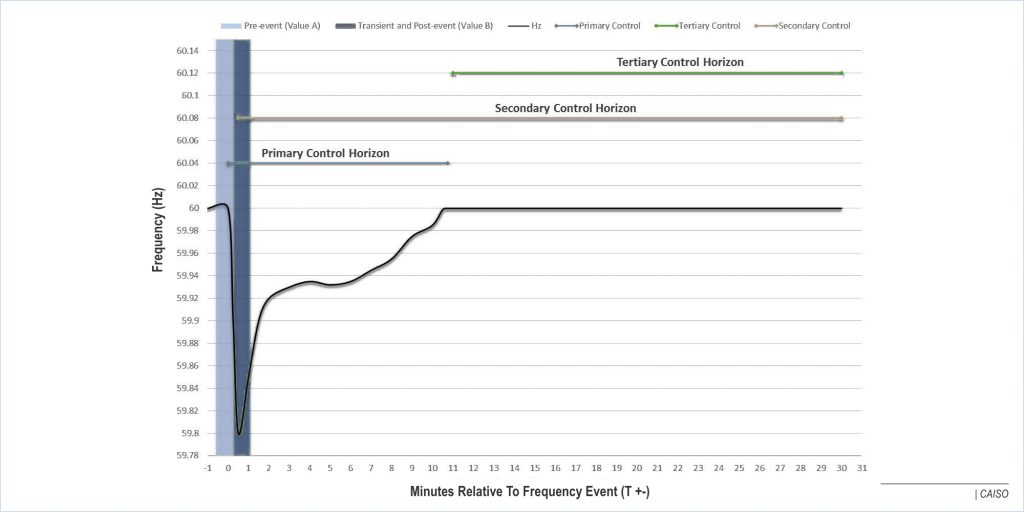By Robert Mullin
CAISO has kicked off an initiative to explore how it can procure resources equipped to automatically respond to disturbances in grid frequency.
The effort will examine implementation of a new market mechanism to compensate resources for providing primary frequency response — sending power into the grid within moments of a potentially destabilizing frequency event.
The new initiative is in response to NERC reliability standard BAL-003-1, which requires each balancing authority area (BAA) to carry sufficient capability to respond to a frequency event.
System operators seek to maintain the grid at a frequency of 60 Hz to maintain network stability. An uncontrolled drop in frequency creates the danger of cascading blackouts.
Under NERC’s standard, primary frequency response is the ability to respond to a deviation within about 20 to 52 seconds of occurrence. Such a rapid reaction requires that the resource automatically detect under-frequency and autonomously ramp its output without receiving a market signal or manual instructions from the ISO.

While the initiative is primarily intended to help CAISO meet NERC’s requirement, the ISO hopes the effort will head off an issue expected to become more problematic as California moves to fulfill its ambitious renewable energy mandate.
“The ISO expects frequency response will worsen as nonconventional technologies increase,” Cathleen Colbert, senior market design and regulatory policy developer at CAISO, said during a Dec. 22 stakeholder call to discuss the initiative.
Nonconventional technologies typically have little or no inertial response to momentary changes on the grid; conventional generators have the ability to automatically vary their turbines’ rotational speed and output based on the pull of load. That built-in capability functions as a kind of damper for frequency excursions.
“The goal of introducing a primary frequency service would be, in the short term, to continue to support compliance with NERC’s frequency response requirement, which, without changes, will be more difficult in the long term as the generation mix changes to accommodate a renewable portfolio standard of 50% renewables by 2030,” the ISO said in an issue paper describing the initiative.
Last month, FERC proposed revising the pro forma generator interconnection agreements to require all newly interconnecting facilities, including renewable generators, to have primary frequency response capability (RM16-6). (See FERC: Renewables Must Provide Frequency Response.)
CAISO’s initiative will focus on whether the ISO should compensate resources for capital expenses associated with the equipment necessary to provide the service. It will also examine making payments for opportunity costs related to holding frequency response capacity in reserve and for operating expenses associated with providing response during an event.
Approved by FERC in 2014, BAL-003-1 requires each BAA to achieve specific performance measures to meet its “frequency response obligation” (FRO), which is calculated as the BAA’s portion of the overall obligation for the interconnection — referred to as the “IFRO.” (See FERC OKs Rules on Geomagnetic Disturbances, Frequency Response.)
The IFRO represents the minimum response needed to halt a decline in frequency resulting from the loss of two of the interconnection’s largest generators — the response necessary to head off reaching the “under-frequency load shedding” threshold of 59.5 Hz.
Based on an assessment of its generation and load relative to the rest of the Western Interconnection, CAISO says that its share of the region’s IFRO stands at about 23% — translating into 196 MW/0.1 Hz next year.
In 2015, CAISO determined that it would likely come up short of its obligation under NERC’s requirements, which took effect Dec. 1. To address the shortfall, the ISO filed Tariff revisions enabling it to enter annual contracts to acquire “transferred frequency response” — the transfer of frequency response performance across BAAs within an interconnection.
At the same time, the ISO committed to FERC that it would evaluate whether it could develop a market mechanism to cultivate a diverse set of resources to help the ISO meet the frequency response criteria.
The ISO is proposing a set of guiding principles for developing a primary frequency response market, which include:
- Creating an environment in which the ISO fleet is positioned to provide sufficient frequency response;
- Eliminating barriers to entry in order to allow all technologies to participate;
- Producing price signals that incentivize adequate response; and
- Ensuring compensation for frequency response-related capital investments if the capability becomes an interconnection requirement.
Stakeholders are being asked to consider whether the ISO’s existing ancillary services market generates sufficient compensation to enable the ISO to meet the NERC’s new reliability requirements.
The most significant argument in favor of developing a new market structure is that the ISO does not currently procure primary frequency response but must still meet NERC’s standard. The existing ancillary services market covers only the requisition of frequency regulation that qualifies as NERC’s “secondary” and “tertiary” control mechanisms following a frequency event — both of which respond to an explicit ISO market signal.
In addition to contracting for transferred response, the ISO relies on unloaded frequency response capability acquired through the current ancillary services procurement, Colbert said. However, resources procured during that process may not have the capability for a sufficiently fast response.
Additionally, the ISO has observed a “deteriorating trend” in its frequency response performance over the past two years when comparing its average capability with its obligation.
“We believe we have received guidance [from FERC] to explore other options,” Colbert said.
Stakeholders must submit comments on the issue paper by Jan. 12, 2017.



